Yorkshire Terrier Winter Care
Overview
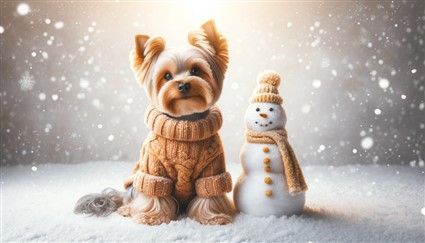
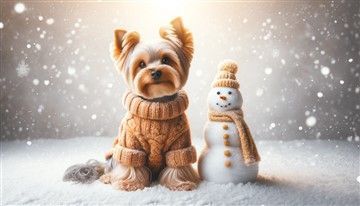
Please note: YorkieInfoCenter is reader-supported. Some links below are affiliate links, meaning we may earn a small commission on products through these, at no extra cost to you.
Tip #1: Protect the paws.
Winter can be harsh on a Yorkie’s paws, with cold weather, ice, snow, and de-icing chemicals all contributing to dry paw pads, that can become cracked if not treated. Winter’s dry air often exacerbates this issue, causing paw skin to dry out similarly to human skin. For these reasons, paw wax can be an essential part of your Yorkie’s winter care, offering a protective barrier against these seasonal hazards.
A quality wax, like Musher’s Secret, can enhance a Yorkshire Terrier’s traction on slippery surfaces to mitigate slips and falls, and it moisturizes and conditions paws to address dryness from low humidity and indoor heating. Additionally, it helps prevent the accumulation of ice balls between the toes, which can lead to painful splits or cracks in the skin by stopping snow from melting and refreezing in their paws.
Despite its benefits, if your walks include areas with heavy use of rock salt or sand, rinse off your Yorkie’s paws to remove these irritants. At home, opt for pet-friendly ice melt products when possible.
Tip #2: Proactively use a humidifier.
Winter air is notoriously dry because cold temperatures reduce the air’s ability to hold moisture, and indoor heating further decreases humidity levels. This dry environment can quickly lead to moisture evaporation from a Yorkshire Terrier’s skin, causing dry, itchy, and flaky skin. The signs of dry skin with Yorkies include itchiness, dandruff, and a dull coat, leading to discomfort and potentially more severe skin conditions if left untreated.
To help prevent the effects of dry winter air, maintain a home humidity level between 30% and 40%. A humidifier can help achieve this balance by adding moisture to the air, alleviating dry skin symptoms for your Yorkie and reducing their discomfort. It’s best to start this proactively in late autumn before dry air takes its toll.
Tip #3: Moisturize and treat dry skin.
Winter can be particularly harsh on a dog’s skin, leading to dryness, flakiness, and irritation. The cold air outside and the dry, heated air inside homes strip moisture from the skin, compromising its integrity and comfort. This can result in itchiness, discomfort, and even more serious skin conditions if not properly managed. To combat these winter woes, three types of products can significantly help maintain your Yorkie’s skin health and coat condition.
Creams: These are perfect for targeting very dry areas on your dog’s skin. Applying these creams at night allows the product to work uninterrupted, giving your Yorkie’s skin a chance to heal and rejuvenate overnight. One that we recommend is Warren London Hydrating Butter that has aloe vera, guava extract and mango extract.
Shampoo and Conditioner: Regular bathing with quality products is vital for maintaining healthy skin and coat. Opt for plant-based formulas that avoid harsh soaping agents, which can further dry out a dog’s skin. Products containing colloidal oatmeal are excellent for both preventing and treating dry skin due to their soothing and moisturizing properties. A recommended choice is Earthbath Shampoo and Conditioner. It is a great option year-round, and its inclusion of oatmeal and aloe makes it particularly beneficial for winter skin protection.
Medicated Sprays: For cases of severe dryness and skin irritation, medicated sprays, especially those containing hydrocortisone can offer relief, designed to soothe and heal irritation and reduce inflammation and discomfort. Veterinary Formula’s Clinical Care Medicated Spray is a top recommendation. It includes lidocaine for pain relief, hydrocortisone to alleviate itching, and allantoin for skin moisturization. Use this spray twice daily, focusing on the affected areas for effective relief.
Tip #4: Keep your Yorkie warm outside with a layered vest.
Outfitting your Yorkshire Terrier with a winter vest or coat is more than just a fashion statement; it's necessary to ensure their warmth and comfort during colder months. Toy breed dogs, like Yorkies, are particularly susceptible to the cold due to their small size and limited fat reserves, providing less natural insulation than larger breeds. This makes them more vulnerable to dropping temperatures, as their bodies are less efficient at retaining heat. In addition, Yorkshire Terriers have a unique, single coat of hair, not fur, offering less protection against the cold and making them prone to quickly feeling chilly.
A winter vest or coat for your Yorkie can be an essential barrier against the cold and wind, mimicking the insulating layer they naturally lack and reducing heat loss. One winter coat that we like a lot is the Norbi Dog Winter Coat which has a built-in harness and a warm fleece inner layer. The extra-small fits Yorkshire Terriers in the 4 lb. to 5 lb. range and the small fits those in the 7 to 8 lb. range, but do measure your little guy or gal before ordering.
Tip #5: Have fun in the snow, with precautions.
Enjoying snow with your Yorkshire Terrier can be wonderful, as many Yorkies love playing in winter settings. Even with a coat or vest on (see previous tip), it’s important to supervise your Yorkie’s playtime and limit their exposure based on their tolerance to the cold. Most Yorkshire Terriers should be brought back in after 15 minutes or so of playing in relatively deep snow.
Be vigilant about noticing signs of hypothermia during cold-weather outings, which can manifest as shivering, lethargy, or weakness and can become a serious health risk if body temperature drops too low. Though less common, frostbite mainly affects a dog’s ears, tail, and paws (areas with less insulation and blood flow). Skin may appear pale or blue at first, then red and swollen as it warms up.
Regarding temperatures that are too cold for a Yorkshire Terrier, it’s generally advised to limit outdoor activities to 15 to 20 minutes when the temperature falls below 32 F (0 C) and to avoid walks if it is under 10 F (-12 C). Always consider the wind chill factor and your Yorkie’s tolerance to the cold, as some may feel uncomfortable even at slightly higher temperatures.
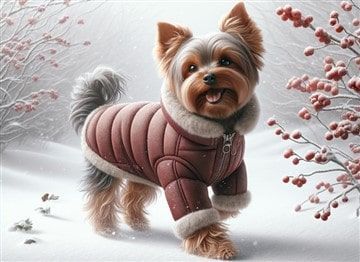
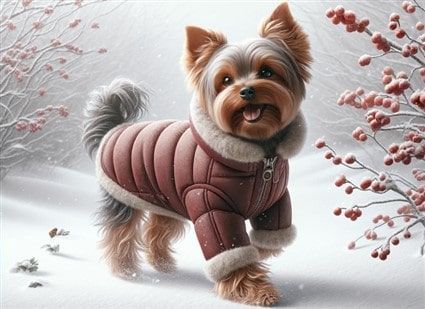
Tip #6: Create a protected bathroom area.
Ensuring your Yorkshire Terrier has a comfortable bathroom area during winter is essential for their comfort and routine. Start by selecting a sheltered spot, ideally protected from wind, and keep it clear of snow. Regular shoveling and the use of pet-safe ice melt can maintain access without the risk of slipping. Placing some straw over the area for insulation and comfort can help protect your Yorkie from the cold ground.
In areas with limited space or for those facing extreme cold and winter blizzards, an indoor solution such as a grass mat or pee pads can be a safe and convenient alternative during unsafe weather conditions. Encourage your Yorkie to use these designated spots through positive reinforcement (praise and training treats).
Tip #7: Provide indoor exercise options.
Many dogs can feel cooped up in the winter, so keeping your Yorkshire Terrier active during this season may require indoor exercise solutions. Since cold weather, storms or short days might limit their outdoor activities, here are some engaging indoor physical activities specifically designed for Yorkshire Terriers:
#1 Hide and Seek: This classic game is fun and stimulates a Yorkshire Terrier’s natural hunting instincts. Start by giving the ‘stay’ command or have a helper keep them in place, then hide somewhere in your home. Call their name and reward them with praise and a small training treat when they find you. It’s an excellent way to get a Yorkie moving and thinking.
#2 Fetch Down a Hallway: If you have a hallway or a long room in your home, it’s the perfect setting for indoor fetch. Use a fun toy like Midlee X-Small Dog Tennis Balls which are sized perfectly for toy breeds like the Yorkie, making them easy to mouth. Keep the vibe excited to prompt energetic fetching for a good dose of physical activity.
#3 Obstacle Course: Create a simple obstacle course using household items. You can set up tunnels via cardboard boxes to crawl through, small items like paper towel tubes to jump over, and pillows to weave around. This not only helps in physical exertion but also helps keep a Yorkie agile and mentally engaged as they navigate through the course
Tip #8: Offer mental stimulation.
In warmer months, Yorkshire Terriers thrive outdoors, engaging their senses fully through walks that satisfy their curiosity and provide necessary exercise and mental stimulation. However, winter can limit these activities, confining them indoors with reduced sensory engagement. This lack of stimulation and fresh air can lead to canine cabin fever, characterized by restlessness, boredom, and possible behavioral issues due to restricted exploration.
To help combat this, offer mentally stimulating activities to keep your Yorkie busy. Snuffle mats, for example, are an enrichment tool designed to mimic the grass or underbrush they would naturally sniff through. They consist of fabric strips on a mat where treats can be hidden, encouraging dogs to use their noses to find rewards, thus keeping their minds active and engaged. We love the Snuffle Mat by Oliumt, which has lots of fun areas to explore with a flower garden design.
Puzzle games are another excellent option, which requires dogs to solve simple problems to access treats. These games come in various forms, such as sliding doors, flipping compartments, or rotating discs. This is a good choice for a bonding activity, as most dogs need their human to guide them (at least in the beginning). One to consider is the Mini Puzzle by KADTC.
Tip #9: Reassess the sleeping area.
When adjusting the sleeping area for your Yorkshire Terrier in the winter, finding the right balance between draft avoidance and proximity to heat sources is important. A spot near an exterior wall might seem cozy, but it can be significantly colder than one in the middle of the room. Electrical outlets located on exterior walls can be sources of drafts, further cooling the area around a dog’s bed.
Provide a warm bed with plenty of bottom cushioning. Check around your little guy or gal’s sleeping area for any drafts coming through electrical outlets or under doors. Consider using draft stoppers for doors and outlet insulating sealers for any drafty outlets. If drafts cannot be resolved, move your Yorkie’s bed to a warmer spot.
Also, please take note that due to heat rising, the temperature at floor level, where a Yorkshire Terrier sleeps on their bed, can be significantly cooler than the air humans experience while standing or sitting on furniture. This discrepancy highlights the importance of ensuring your Yorkie’s sleeping area is adequately warm, even if the room feels comfortable to you.
Tip #10: Keep a schedule despite shorter daylight hours.
Winter daylight hours can be significantly shorter than summer days, decreasing by up to half in some regions. For instance, while a summer day might boast 15 to 16 hours of daylight, a winter day could see as few as 8 to 9 hours. This drastic change can disrupt a dog’s internal clock, throwing off their regular feeding, walking, and sleeping schedule. Maintaining a consistent schedule is vital, as it provides a Yorkshire Terrier with a sense of security and predictability, which is essential for their mental health and well-being.
To counteract the effects of shorter days, try to maintain a schedule regardless of whether the sun is up or down. Use artificial lighting to mimic daylight patterns, encouraging activity during “daytime” hours to help maintain your Yorkshire Terrier’s internal clock. Stick to regular feeding times, walks, grooming and playtimes as closely as possible, even if it means walking your Yorkie in the dark (with appropriate safety gear like reflective vests and flashlights).
Summary
- Protect the paws.
- Proactively use a humidifier.
- Moisturize and treat dry skin.
- Keep your Yorkie warm outside with a layered vest.
- Have fun in the snow, with precautions.
- Create a protected bathroom area.
- Provide indoor exercise options.
- Offer mental stimulation.
- Reassess the sleeping area.
- Keep a schedule despite shorter daylight hours.
Wintertime FAQ

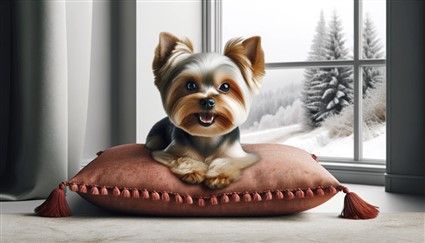
Can a Yorkshire Terrier get fleas in the winter?
Yes, Yorkshire Terriers can still catch fleas in the winter. Interaction with other pets, such as at doggie daycare or during playdates, can lead to flea transfer. Indoors, in warm environments, these pests thrive regardless of the cold outside, underscoring the need for year-round prevention. Regular use of vet-recommended flea treatments is essential. Additionally, keeping your home clean by vacuuming frequently and washing your Yorkie's bedding can help minimize the risk of flea infestation.
Can a Yorkie get ticks in the winter?
Ticks can pose a threat to dogs in the winter, particularly in regions where temperatures stay above 45°F (7°C), as ticks can remain active in this temperature range. Even on warmer winter days, they can be found in protected spots like tall grasses or brush. To safeguard your Yorkie, it's crucial to use tick prevention products year-round and thoroughly check for ticks after outdoor activities, regardless of the season.
Do Yorkshire Terriers eat more in the winter?
Yorkies might require more food in the winter if they spend a lot of time outdoors being active, as they burn more calories to keep warm. However, for mostly indoor pets, dietary needs may not change significantly. Monitor your Yorkie’s activity level and adjust their food intake accordingly.
What are tips for senior Yorkshire Terriers for the winter?
Winter poses some challenges for senior Yorkshire Terriers, particularly for those suffering from arthritis, as cold weather can intensify joint pain and hinder mobility. To alleviate discomfort, keep your senior Yorkie cozy with dog sweaters and/or a heated bed, and consider installing ramps for easier access to furniture or stairs.
Regular, gentle exercise is key to maintaining joint mobility in senior Yorkies; however, to prevent falls, ensure to avoid slippery surfaces. Enhancing safety further, applying paw wax can improve their traction on slick areas.
Additionally, adding dietary supplements such as omega-3 fatty acids, glucosamine, and chondroitin into their diet can bolster joint health and help alleviate pain. If your older Yorkshire Terrier’s mobility seems particularly affected by the colder months, speak to the vet about prescribed medications and other treatments.
More Articles:
How to Clean Your Yorkie's Teeth - This breed is extremely prone to tooth decay and other painful issues that can lead to tooth loss, bone deterioration and more. Follow these tips to keep your Yorkie's teeth clean and healthy.
Yorkshire Terrier Do and Don't List - A super-helpful concise guide on the most important do's and the most vital don'ts for this amazing toy breed. How many are you following?
